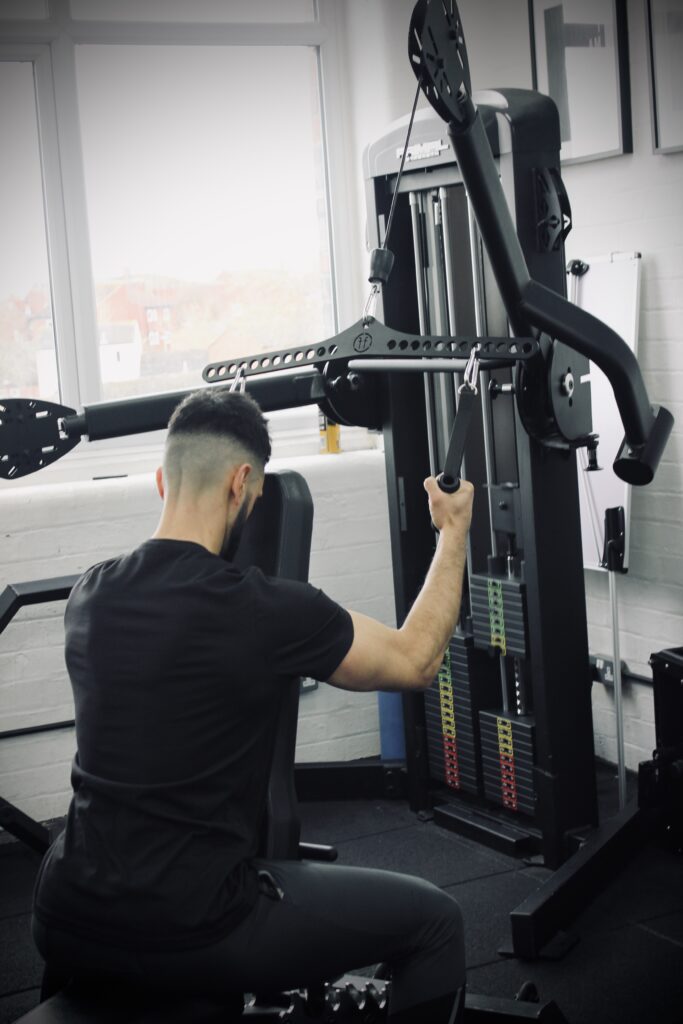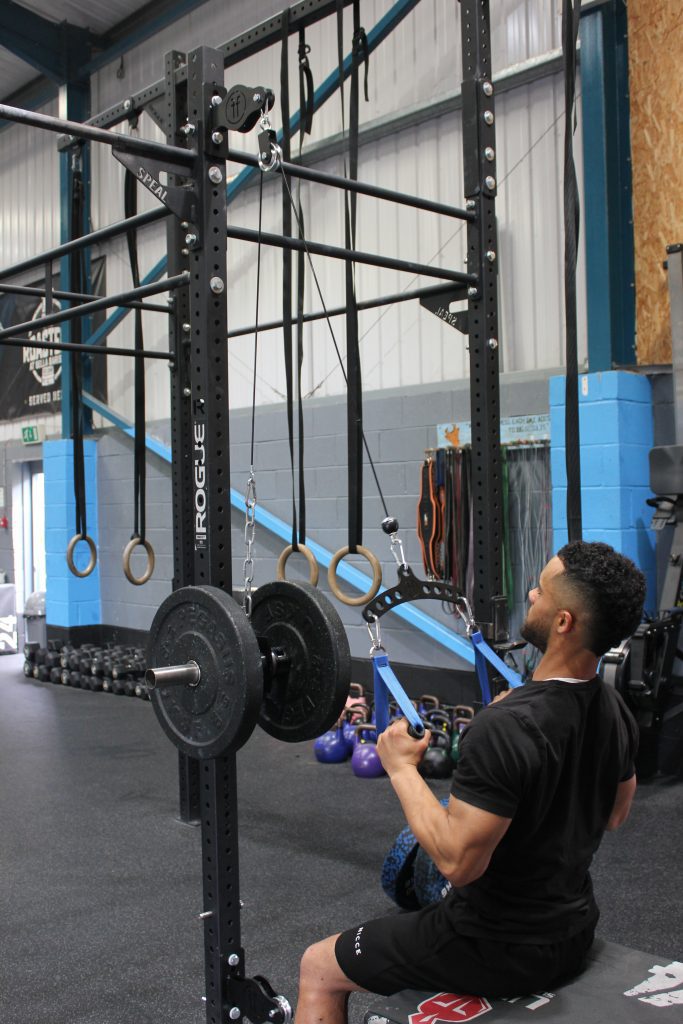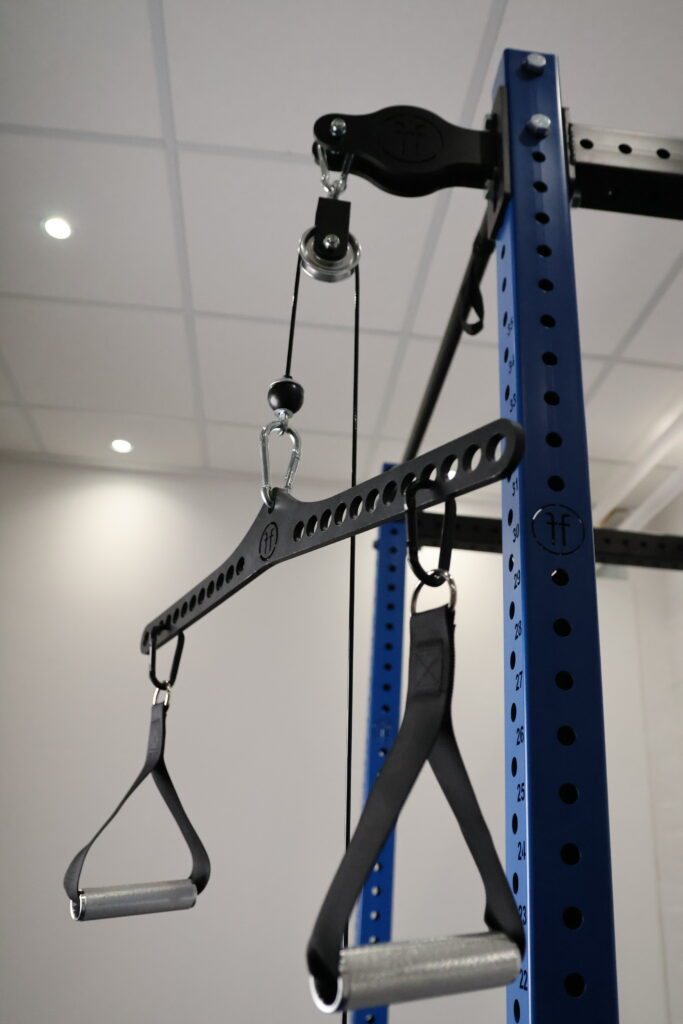What is the best attachment for a lat pulldown?

Share This Post
Understanding Lat Pulldown Attachments
The lat pulldown is an essential exercise for developing a strong and well-defined back, and the attachments used can significantly influence the effectiveness of the workout. In this article, we delve into the importance of these attachments and the benefits of incorporating various types into your training regimen.
Importance of Lat Pulldown Attachments
Lat pulldown bar attachments are vital for targeting different muscle groups of the back, particularly the latissimus dorsi, which are the broadest muscles of the back.
The right attachment offers not just variation but also customisation of the exercise to better suit individual body mechanics and training goals. With options ranging from standard straight bars to specialised handles, the choice of attachment can make a significant difference in muscle engagement and the overall intensity of the workout.
Benefits of Using Different Attachments
Each lat pulldown bar attachment provides its own unique benefits and can introduce a different stimulus to the muscles. Muscle & Fitness notes the multitude of attachments available, each designed to enhance your training experience by:
- Targeting different areas of the back: The lat pulldown bar attachment offers a variety of grip positions, which can shift the focus to the upper lats, improve grip strength, and incorporate the biceps and upper back into the movement.
- Preventing plateaus: Using different attachments can prevent your muscles from becoming too accustomed to a single type of movement, thereby continuously challenging them and promoting growth.
- Adapting to individual needs: Personal preferences and physical limitations can be accommodated by selecting attachments that offer comfort and effectiveness for each individual’s body type.
Attachment Type | Target Area | Benefits |
Straight Bar | Wide/Neutral/Narrow Lats | Versatile grip positions |
V-Bar | Middle Lats | Concentrated contraction |
Multi-Grip | Various Lats and other muscles | Multiple grip options |
Rope | Lower Lats | Increased range of motion |
Cable Row | Upper Lats/Back | Incremental grip adjustments |
It’s clear that incorporating a variety of attachments into your lat pulldown routine can greatly enhance the workout’s effectiveness. To learn more about specific grip techniques, visit our articles on wide or neutral grip for lat pulldowns and close-grip lat pulldowns. Additionally, for those seeking alternatives to the traditional lat pulldown, check out our suggestions on lat pulldown exercise alternatives.

Exploring Lat Pulldown Exercises
The lat pulldown is a staple exercise for those seeking to strengthen and develop their upper back muscles, specifically the latissimus dorsi. The effectiveness of this exercise can be significantly impacted by the type of grip and attachment used. In this section, we will examine two common variations of the lat pulldown: the wide grip and the narrow grip.
Wide Grip Lat Pulldown
The wide grip lat pulldown is a variation where the individual’s hands are positioned just outside the width of their shoulders. This grip targets the outer portion of the lats more than the traditional lat pulldown, placing less tension on the biceps and forearms, and consequently making the lats work harder during the movement.
Grip Type | Targeted Muscle | Biceps Tension | Latissimus Dorsi Activation |
Wide Grip | Outer Lats | Reduced | High |
Studies, like the one performed by Signorile, Zink, and Szwed in 2002, have indicated that a wide-grip lat pulldown performed in front of the neck might produce the highest activation of the latissimus dorsi. For more detailed information on grip variations, visit our page on wide or neutral grip for lat pulldowns.
Narrow Grip Lat Pulldown
The narrow grip lat pulldown utilises a closer hand placement, typically narrower than shoulder-width apart. Research by Andersen et al. in 2014 suggests that while there is similar activation of the latissimus dorsi between the various grip widths during the concentric phase, the narrow grip may cause higher activation levels in the biceps brachii compared to wider grips.
Grip Type | Targeted Muscle | Biceps Tension | Latissimus Dorsi Activation |
Narrow Grip | Central Lats | Increased | High |
A narrow grip can be beneficial for those looking to engage their biceps in conjunction with their lats, making it a slightly more compound movement. For individuals looking to focus on the central part of their lats or increase bicep engagement, the narrow grip lat pulldown is an excellent choice. Explore our insights on close-grip lat pulldowns for more details.
Both the wide grip and narrow grip lat pulldown exercises are effective for developing the latissimus dorsi. The choice between them can depend on personal preferences, specific muscle targeting, and fitness goals. It’s also worth noting that incorporating a variety of grip positions can be advantageous for comprehensive muscle development. Those looking for alternative exercises to the lat pulldown can find additional options on our lat pulldown exercise alternatives page.

Choosing the Best Lat Pulldown Attachment
When it comes to sculpting the latissimus dorsi muscles, commonly known as the lats, the choice of lat pulldown attachment can make a significant difference in muscle activation and the effectiveness of the workout. This section will guide individuals through the considerations for selecting the best attachment for a lat pulldown and highlight some of the most popular attachments available in the UK.
Considerations for Selecting Attachments
Selecting the right lat pulldown attachment involves considering several factors to ensure that the attachment aligns with the individual’s fitness goals and comfort preferences:
- Muscle Activation: The ideal attachment should target the lats more effectively than other exercises or equipment.
- Exercise Variation: Different attachments allow for a variety of exercises. It’s beneficial to choose an attachment that offers unique benefits and allows for multiple grip positions.
- Comfort and Grip: The attachment should be comfortable to use, with a grip that does not strain the wrists or hands.
- Durability: High-quality materials and construction ensure the attachment withstands regular use.
- Compatibility: Ensure the attachment fits the cable machine being used, as connection points can vary.
By considering these factors, individuals can select an attachment that not only enhances their workout but also supports their overall training objectives. Those unsure of which grip to use can find more information in our articles on wide or neutral grip for lat pulldowns and close-grip lat pulldowns.
Popular Lat Pulldown Attachments
Several lat pulldown attachments stand out due to their effectiveness and popularity:
- The Lat Pulldown Bar Attachment: Known for its incremental rungs, which provide various grip options, this attachment focuses on the upper back and lats, also engaging the biceps and grip strength.
- The premium lat bar: Offers a comfortable neutral grip, targeting the upper back and lats while minimising bicep involvement, promoting more engagement of the forearm flexors and upper back.
The versatile multi-grip attachment: Features four neutral grip positions, ideal for hitting the lower lats and adding thickness to the upper back. However, its weight may pose a challenge when getting into position.
Attachment Type | Target Areas | Weight | Grip Variations |
Lat Pulldown Bar Attachment | Upper lats, biceps, grip | Varies | Multiple |
Premium lat bar | Upper back, lats | Varies | Neutral |
Multi-Grip | Lower lats, upper back | ~23 lbs | Four neutral |
For further exploration of lat pulldown exercises and alternatives, readers are encouraged to visit our article on lat pulldown exercise alternatives.
By carefully considering the type of attachment and how it aligns with specific workout goals, individuals can maximise their lat pulldown workouts and see significant improvements in their back strength and muscle definition.

Maximising Your Lat Pulldown Workout
To fully benefit from lat pulldown exercises, it’s crucial to focus on proper form and technique. Incorporating advanced variations can further enhance muscle engagement and development.
Proper Form and Technique
Executing the lat pulldown with correct form is essential for targeting the intended muscle groups and preventing injury. The primary muscle worked during this exercise is the latissimus dorsi, the broadest muscle in the back. Here are key points to ensure proper form:
- Sit with your knees secured under the pads.
- Grasp the bar with a pronated grip (palms facing forward) that’s wider than shoulder-width for a standard wide grip pulldown. For a narrow grip, hands should be closer together.
- Lean back slightly and brace your core.
- Pull the bar down smoothly to chest level without swaying, leading with your elbows.
- Squeeze your shoulder blades together at the bottom of the movement, then slowly return to the starting position.
A study by Lusk et al. in 2009 found that a pronated grip activates the latissimus dorsi more than a supinated grip, with no significant difference in biceps brachii or middle trapezius activation amongst various grips, supporting the use of a pronated grip for maximising lat engagement.
Advanced Lat Pulldown Variations
Once you’ve mastered the standard lat pulldown with proper form, consider exploring advanced variations to challenge your muscles further:
- Wide Grip Front Pulldown: This variation emphasises the upper lats and teres major. A study by Signorile, Zink, and Szwed in 2002 suggested that a wide grip in front of the neck produced the greatest activation of the latissimus dorsi. However, it’s important to avoid pulling the bar behind the neck as this can strain the shoulders and neck.
- Close-Grip Front Pulldown: By using a closer grip, there’s increased biceps brachii involvement. Andersen et al. in 2014 reported higher biceps activation with a narrow or medium grip compared to a wide grip during the concentric phase.
- Reverse Grip Pulldown: Switching to a supinated grip (palms facing you) can shift some of the focus to the lower lats and biceps.
When considering the best attachment for a lat pulldown, it’s important to choose one that complements your grip preference and fitness goals. For more information on grip techniques, refer to our articles on wide or neutral grip for lat pulldowns and close-grip lat pulldowns.
Incorporating a variety of grips and attachments in your workout regime can help to evenly develop the back muscles and prevent plateaus. For individuals looking to explore beyond traditional pulldown exercises, lat pulldown exercise alternatives offer a range of options to keep your workouts fresh and engaging. By paying close attention to form and continuously challenging your muscles with new variations, you can maximise the effectiveness of your lat pulldown workouts.

More To Explore
The Ultimate Guide to Skipping: Unlocking Strength, Balance, and Stress Relief with a flow rope
Flow rope training is a dynamic workout method that involves using a thick braided rope to create rhythmic, fluid movements. Unlike traditional jump rope exercises, a flow rope workout doesn’t necessarily require jumping. Instead, you move with the rope rather than against it, making it an excellent workout for balance, coordination, and relaxation. Popular among
The Benefits of Training with a Weighted Vest: Boost Your Strength and Endurance
Integrating a weighted vest into workout routines is an increasingly popular fitness strategy aimed at enhancing the effectiveness of various exercises. This comprehensive guide examines how weighted vests can significantly boost physical fitness by increasing the intensity of workouts, details the potential risks, and offers insights into maximising benefits while minimising potential drawbacks. What is